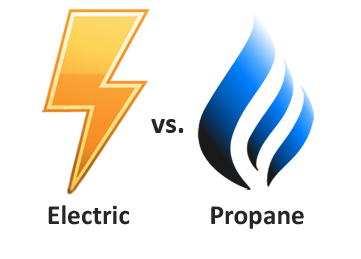alternative options such as auto propane and electric to meet their sustainability goals. While electric vehicles have
received much attention, there are several important factors fleet owners must consider when determining which
fuel is their best option. (The following information was sourced from Richard Tackett’s article, Do you plan to
refuel or propel your electric vehicle? published in BUSRide Magazine May 1, 2019.)
Think about infrastructure costs
When transitioning to propane autogas or electric vehicles, fleet owners and operators need to identify all visible and hidden costs that go along with refueling or recharging infrastructure installations, because there are some dramatic differences between the two. Below is a breakdown of infrastructure costs between the two alternatives, comparing each based on a fleet size of 10 vehicles.
The cost to install infrastructure for 10 propane autogas vehicles with a single 1,000- to 2,000-gallon tank is up to $60,000, including as much as $36,000 for site preparation and equipment, and up to $24,000 for installation. In some cases, a propane supplier may own the infrastructure and lease it to fleet owners, lowering the overall costs.
In comparison, the cost to set up infrastructure for 10 electric vehicles with five level 3 fast EV chargers is up to $480,000, including as much as $200,000 for site prep and equipment, and up to $280,000 for installation. Unlike propane autogas infrastructure, electric infrastructure will most likely have additional costs for items like electric sub-panels, added amperage to power multiple stations, and upgrading and replacing incoming power lines. Similar to propane autogas, electric vehicle recharging stations also have a leasing option.
Fuel options abound for emissions reductions
One of the primary reasons operators transition to using alternative propulsion is to reduce their emissions, whether it’s mandated by federal, provincial or local government regulations or simply part of a company’s mission. Thanks to emerging propane autogas technology from companies like Roush CleanTech and others, propane autogas is delivering near-zero emissions for its customers. New “ultra-low NOx” propane engines are 98 percent cleaner than current standards mandated by the Environmental Protection Agency (EPA). سباق الهجن
In recent years electric vehicles’ popularity has increased because the technology is perceived as clean and green with zero emissions. However, it is important to note that emissions may be created by the source of electric power generation or the fleet owner’s choice for required auxiliary heating options and should be included in the comparisons.
While both options exceed EPA mandated tailpipe emissions levels, there are some differences in emissions throughout the full emissions cycle of the vehicles. Propane autogas can emit 70 percent fewer sulfur oxide (SOx) emissions and up to 45 percent less particulate matter than electric vehicles from well-to-wheels.
Is the fleet going to grow?
Fleet owners should also keep in mind the need for scalability as their fleet increases, because the costs to expand infrastructure required to accommodate a growing fleet are drastically different for the two forms of propulsion.
Propane autogas refueling stations can easily grow to accommodate increasing fleet size with more fuel storage tanks or larger ones. In comparison, electric charging stations may require additional chargers, additional panels to accommodate amperage, new power drops (the overhead electrical line running from a utility pole to the customer’s building), upgrades to the grid transformer so the electric company can supply the power necessary for the site, and additional ventilation if charging in a covered area, if the EV fleet size increases.
Consider the refueling process itself
In addition to the cost of fuel and infrastructure installation, fleet owners should consider the amount of down time required for refueling or recharging. With propane autogas, the quick-connect nozzle and fuel dispenser provides a quick, convenient and safe refueling experience which requires minimal downtime, allowing drivers to get back on the route.
With electric vehicles using a standard charger, vehicles require 8 to 10 hours to reach a full charge and express chargers require 1.6 hours to reach a full charge. This requires fleet owners to plan downtime for vehicles before they are back up and on the road. طاولة القمار For comparison, a fleet of 10 propane autogas vehicles can refuel from a single hose in just over two hours. Recharging a fleet of 10 similar electric vehicles in the same time frame would require separate charging stations for every one or two vehicles. البير ميونخ
Additional costs and performance
As with any fuel alternative there are additional costs associated with more than just the infrastructure. There’s also the refueling/recharging costs themselves. Propane autogas refueling costs are stable throughout the year, and fleet managers can secure lower prices by securing a fuel contract. Electricity costs vary throughout the day and can increase if the demand for power exceeds a station’s capabilities. In comparison, propane autogas refueling stations also have lower annual maintenance costs than similar capacity electric vehicle recharging stations.
When you factor in the cost of a new vehicle, regardless of fuel type and the costs for fuel, fluids, maintenance and repairs over the lifetime of the vehicle, propane autogas has the lowest cost of any fuel for the lifetime of the vehicle.

